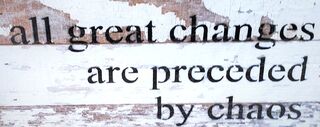Coronavirus Disease 2019
The COVID-19 Pandemic as a Crisis—and a Creative Catalyst
A crisis can be an opportunity to reimagine and reinvent your world.
Posted February 5, 2021
By popular definition, a crisis is "any event or period that will lead, or may lead, to an unstable and dangerous situation affecting an individual, group, or all of society." The COVID-19 pandemic certainly fits that description. For the past year, we’ve faced a major threat to our physical and mental health, economy, and social connectedness. The pandemic has had a destabilizing effect on nearly every aspect of our lives. At the same time, we’ve shown amazing resilience, resourcefulness, and creativity. From clever face mask designs and homemade hand sanitizer, virtual theater productions, and live-streamed dueling piano concerts, to transformation in schools and businesses, in many areas we’ve not only coped—we’ve thrived.
The totality of our current situation is not reflected in the standard definition of crisis, which underscores the element of danger. In contrast, the Japanese word for crisis (危機, pronounced kiki) reflects a more balanced perspective: 危 refers to danger; and 機 represents a pivotal moment or opportunity. By reframing crisis in this way, we pay attention to danger and opportunity.

The burst of creativity we’ve seen during the pandemic is no accident. The chaotic nature of the whole situation has acted as a creative catalyst. Innovation thrives when we question the status quo, take risks, and try new approaches—basically, when we think outside the box. And that’s exactly what we’ve been doing. We’ve had to change our routines, question our assumptions, and even rethink our idea of celebrations with family and friends. Parents have taken on the role of teachers; security guards have been tasked with COVID-19 screening. Uncertainty has become the norm. The pandemic has not only changed the status quo—it’s smashed the box. In doing so, it’s created an ideal climate for innovation.
Reframing crisis also means recognizing the value of destructive forces. Destabilization shows us the fault lines; areas of weakness that break under pressure. The chaos of the pandemic has revealed fractures in education and healthcare and exposed sociocultural and political divisions. These rifts are opportunities. The breakdown of structure offers us a chance to redesign—not just rebuild and re-establish the status quo. Now is the perfect time to question old practices, redefine goals, and explore new possibilities.
Looking Ahead
Post-pandemic: Will everything go back to normal? Perhaps the better question is should everything go back to normal? COVID-19 has inspired strategies and solutions that may be valuable even after we regain a sense of safety and stability. Mask-wearing is likely to remain a wise practice in airplanes, airports, and other venues where travelers are in close proximity. Online appointments with health care providers, expansion of virtual education, and remote work options have begun to redefine accessibility; and we’ve barely tapped the potential in these areas. Instead of waiting for life to resume as though it were paused for a year, why not consider more change? As we stand in line for our COVID-19 vaccine, let’s not forget … in crisis, there is opportunity.


